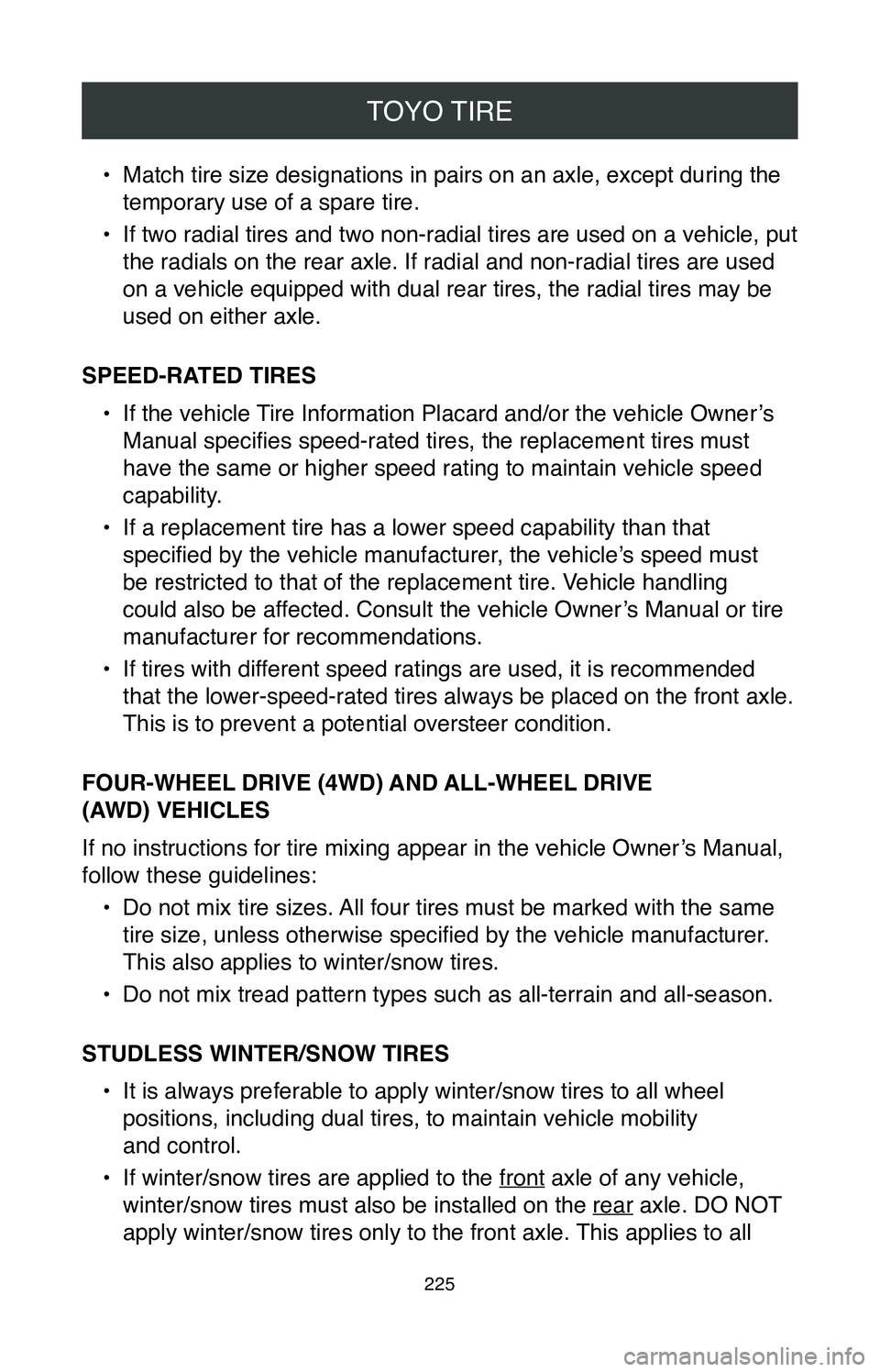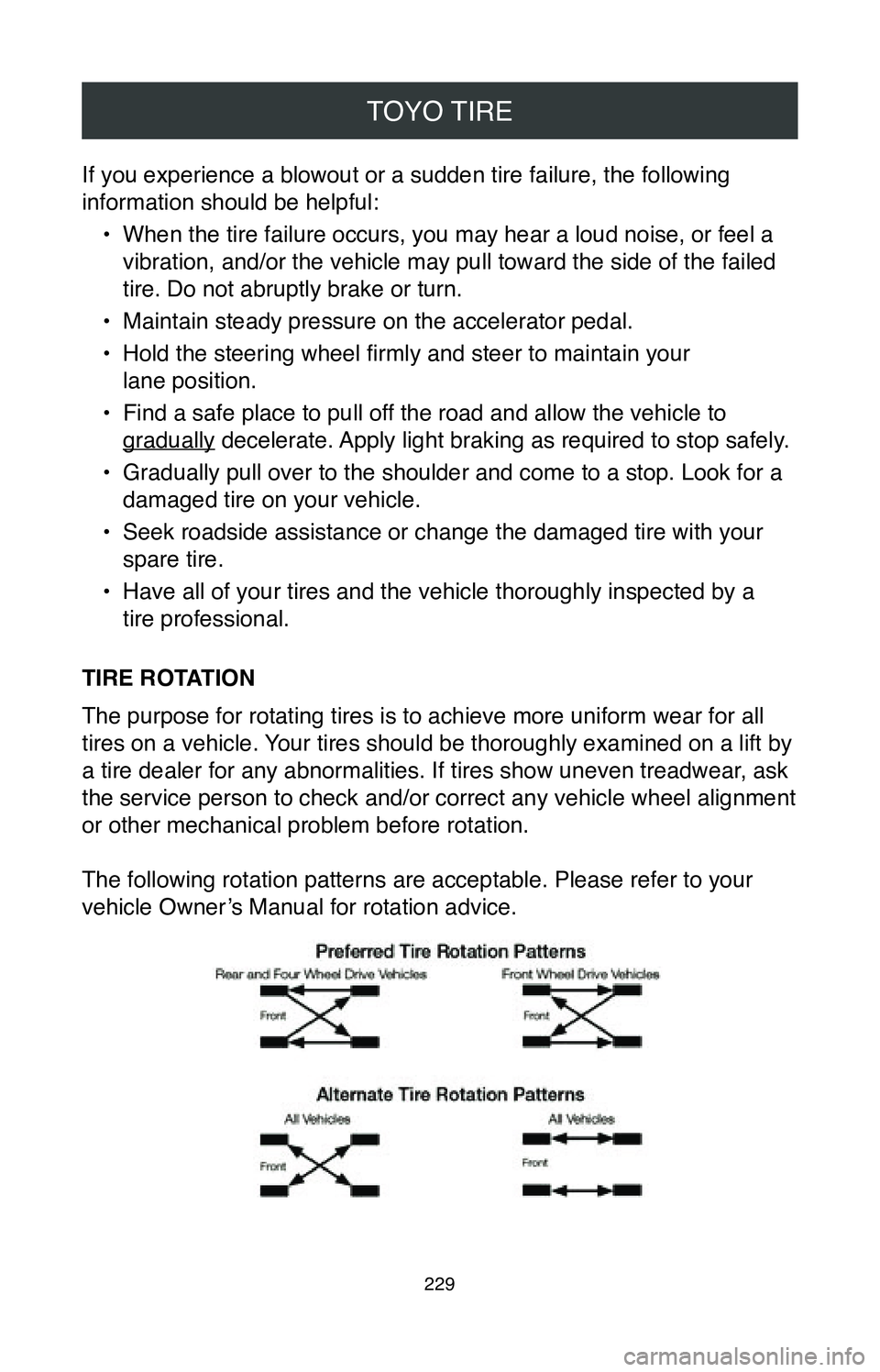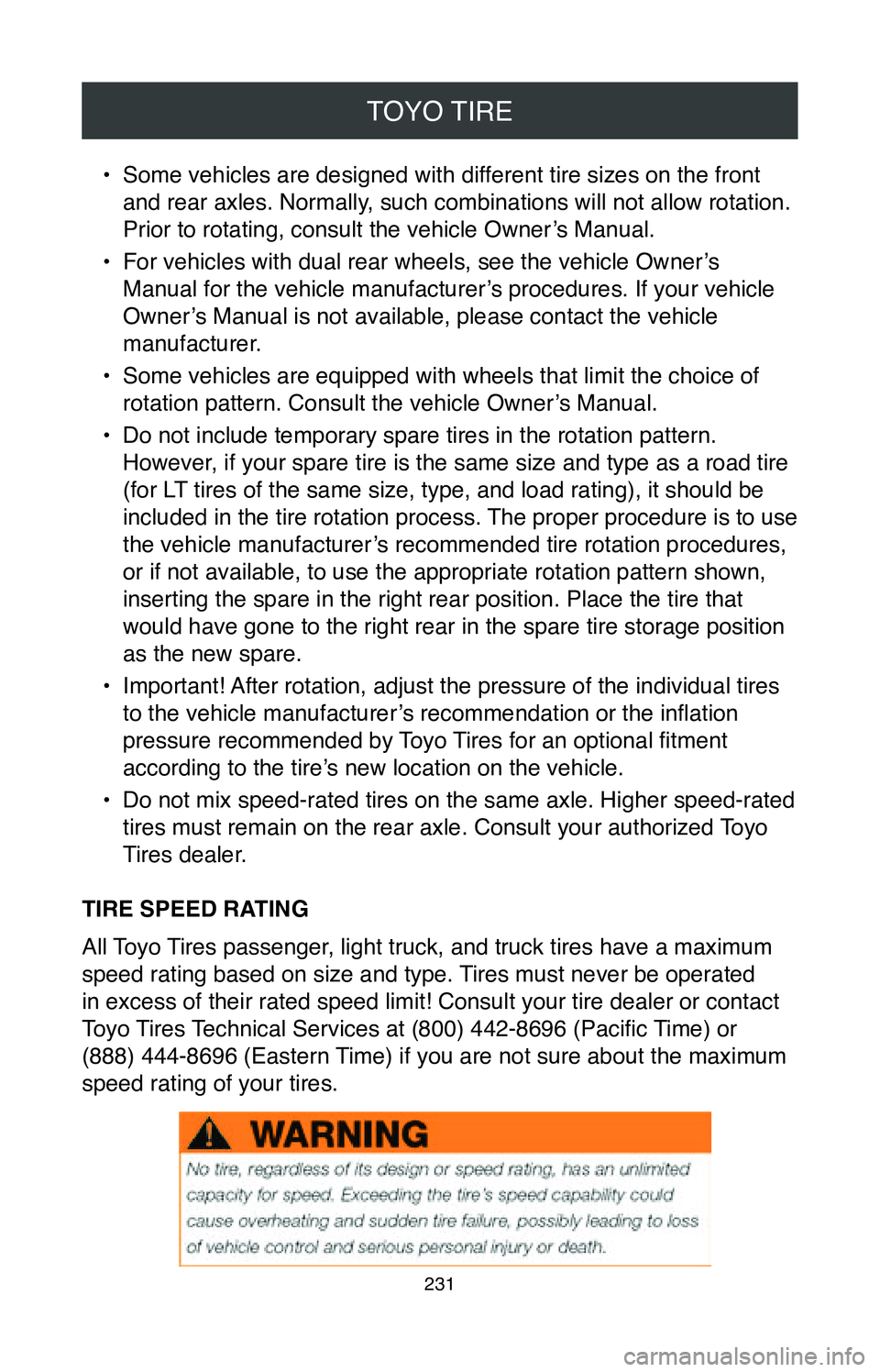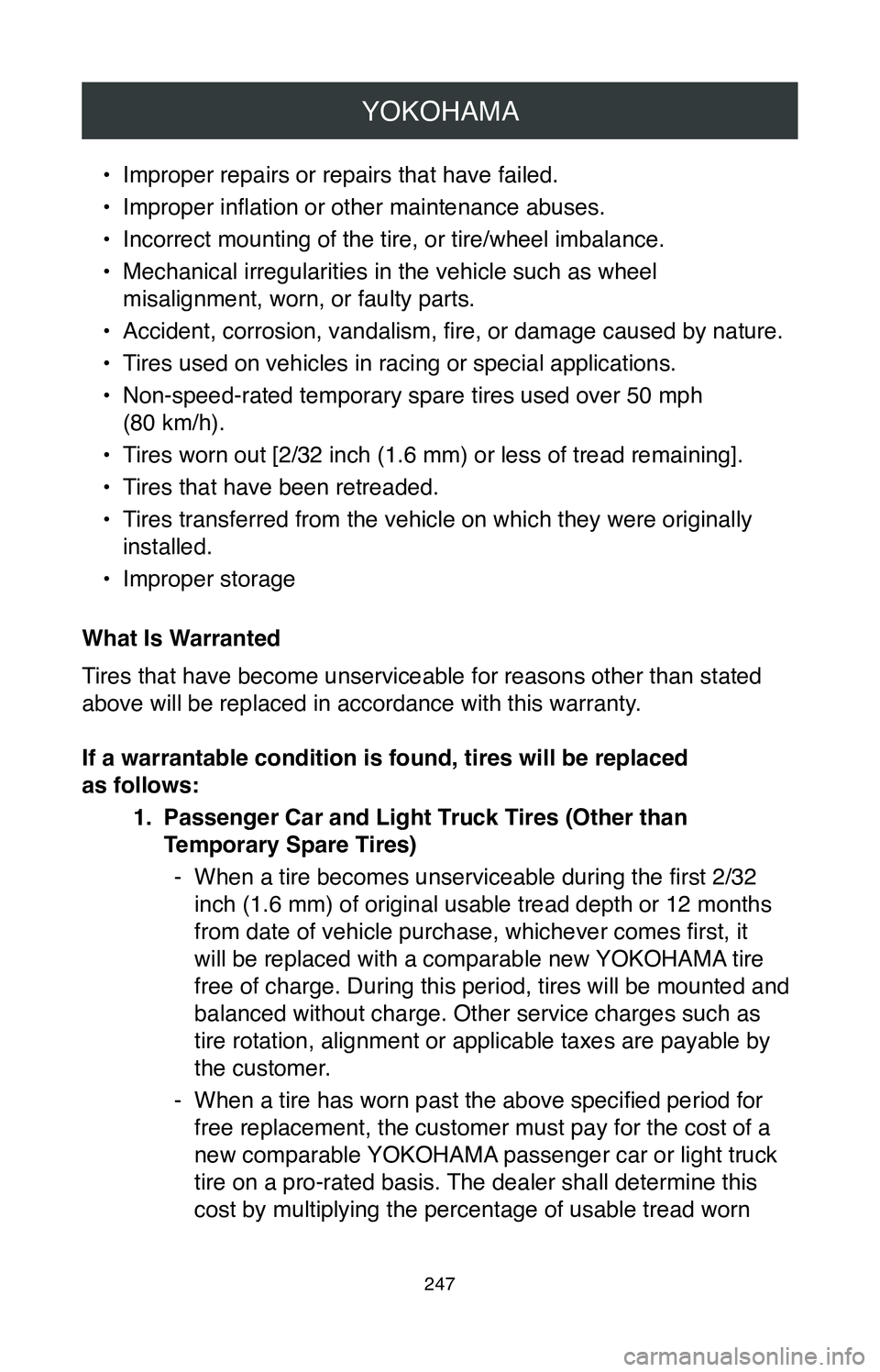wheel TOYOTA COROLLA 2020 Warranties & Maintenance Guides (in English)
[x] Cancel search | Manufacturer: TOYOTA, Model Year: 2020, Model line: COROLLA, Model: TOYOTA COROLLA 2020Pages: 260, PDF Size: 8.54 MB
Page 225 of 260

TOYO TIRE
223
• Proper spacing between dual tires is necessary for optimum tire
performance. If chains are used, particular care must be taken
to assure adequate clearance between loaded tires to avoid
damage from the chains. The allowable outside diameter
difference between a tire and its dual mate is 1/4” (6.4 mm) for
light truck tires.
Considerations in Plus Sizing
Always refer to and follow the vehicle manufacturer’s replacement
tire recommendations. In some cases, a vehicle manufacturer may
specifically advise against the application of replacement tires that are
not of the original size or type.
TIRE AND WHEEL MATCHING AND MOUNTING
Page 227 of 260

TOYO TIRE
225
• Match tire size designations in pairs on an axle, except during the
temporary use of a spare tire.
•
If two radial tires and two non-radial tires are used on a vehicle, put
the radials on the rear axle. If radial and non-radial tires are used
on a vehicle equipped with dual rear tires, the radial tires may be
used on either axle.
SPEED-RATED TIRES •
If the vehicle Tire Information Placard and/or the vehicle Owner’s
Manual specifies speed-rated tires, the replacement tires must
have the same or higher speed rating to maintain vehicle speed
capability.
•
If a replacement tire has a lower speed capability than that
specified by the vehicle manufacturer, the vehicle’s speed must
be restricted to that of the replacement tire. Vehicle handling
could also be affected. Consult the vehicle Owner’s Manual or tire
manufacturer for recommendations.
•
If tires with different speed ratings are used, it is recommended
that the lower-speed-rated tires always be placed on the front axle.
This is to prevent a potential oversteer condition.
FOUR-WHEEL DRIVE (4WD) AND ALL-WHEEL DRIVE
(AWD) VEHICLES
If no instructions for tire mixing appear in the vehicle Owner’s Manual,
follow these guidelines: •
Do not mix tire sizes. All four tires must be marked with the same
tire size, unless otherwise specified by the vehicle manufacturer .
This also applies to winter/snow tires.
•
Do not mix tread pattern types such as all-terrain and all-season.
STUDLESS WINTER/SNOW TIRES •
It is always preferable to apply winter/snow tires to all wheel
positions, including dual tires, to maintain vehicle mobility
and control.
•
If winter/snow tires are applied to the front axle of any vehicle,
winter/snow tires must also be installed on the rear axle. DO NOT
apply winter/snow tires only to the front axle. This applies to all
Page 228 of 260

TOYO TIRE
226
passenger and light truck vehicles, including front-wheel-drive,
4WD, and AWD vehicles.
•
If winter/snow tires are installed on the rear axle of any vehicle, it is
recommended (but not required) that they also be installed on the
front axle.
STUDDED WINTER/SNOW TIRES
•
Studded winter/snow tires have higher traction qualities under
most winter weather conditions.
•
If studded winter/snow tires are installed on the front axle of any
vehicle, studded winter/snow tires must also be installed on the
rear axle. DO NOT apply studded winter/snow tires only to the
front axle.
•
If studded winter/snow tires are installed on the rear axle of any
vehicle, it is strongly recommended that they should also be
installed on the front axle. Only if studded winter/snow tires are
installed on all wheel positions of a vehicle will optimum handling
characteristics be achieved.
Page 229 of 260

TOYO TIRE
227
REPLACING TWO TIRES•
When a pair of replacement tires is selected in the same size and
construction as those on the vehicle, the two newer tires must be
installed on the rear axle and must be of equal or higher speed
rating than the front tires. Generally, new tires with deeper tread
will provide better grip and evacuate water more effectively, which
is important as a driver approaches hydroplaning situations.
Placing greater traction on the rear axle on wet surfaces is
necessary to prevent a possible oversteer condition and loss of
vehicle stability.
•
When two new tires have been installed onto the rear axle
positions, they are to be kept on the rear but rotated from side
to side. This is recommended after installing two new tires to the
rear position, or if you discover significant tread depth differences
between the front and rear positions during rotation intervals.
REPLACING ONE TIRE •
Replacing a single tire on a vehicle can have an adverse effect on
suspension systems, gear ratios, transmission, and tire treadwear.
•
If single tire replacement is unavoidable, it is recommended that
the single new tire be paired with the tire that has the deepest
tread and both be placed on the rear axle. Placing greater traction
on the rear axle on wet surfaces is necessary to prevent a possible
oversteer condition and loss of vehicle stability.
WHEEL ALIGNMENT AND BALANCING •
Proper wheel alignment and balance are very important
considerations for safety and getting the maximum mileage from
your tires. You need to check how your tires are wearing at least
once a month.
Page 231 of 260

TOYO TIRE
229
If you experience a blowout or a sudden tire failure, the following
information should be helpful:•
When the tire failure occurs, you may hear a loud noise, or feel a
vibration, and/or the vehicle may pull toward the side of the failed
tire. Do not abruptly brake or turn.
•
Maintain steady pressure on the accelerator pedal.
•
Hold the steering wheel firmly and steer to maintain your
lane position.
•
Find a safe place to pull off the road and allow the vehicle to
gradually decelerate. Apply light braking as required to stop safely.
•
Gradually pull over to the shoulder and come to a stop. Look for a
damaged tire on your vehicle.
•
Seek roadside assistance or change the damaged tire with your
spare tire.
•
Have all of your tires and the vehicle thoroughly inspected by a
tire professional.
TIRE ROTATION
The purpose for rotating tires is to achieve more uniform wear for all
tires on a vehicle. Your tires should be thoroughly examined on a lift by
a tire dealer for any abnormalities. If tires show uneven treadwear, ask
the service person to check and/or correct any vehicle wheel alignment
or other mechanical problem before rotation.
The following rotation patterns are acceptable. Please refer to your
vehicle Owner’s Manual for rotation advice.
Page 233 of 260

TOYO TIRE
231
• Some vehicles are designed with different tire sizes on the front
and rear axles. Normally, such combinations will not allow rotation.
Prior to rotating, consult the vehicle Owner’s Manual.
•
For vehicles with dual rear wheels, see the vehicle Owner’s
Manual for the vehicle manufacturer’s procedures. If your vehicle
Owner’s Manual is not available, please contact the vehicle
manufacturer.
•
Some vehicles are equipped with wheels that limit the choice of
rotation pattern. Consult the vehicle Owner’s Manual.
•
Do not include temporary spare tires in the rotation pattern.
However, if your spare tire is the same size and type as a road tire
(for LT tires of the same size, type, and load rating), it should be
included in the tire rotation process. The proper procedure is to use
the vehicle manufacturer’s recommended tire rotation procedures,
or if not available, to use the appropriate rotation pattern shown,
inserting the spare in the right rear position. Place the tire that
would have gone to the right rear in the spare tire storage position
as the new spare.
•
Important! After rotation, adjust the pressure of the individual tires
to the vehicle manufacturer’s recommendation or the inflation
pressure recommended by Toyo Tires for an optional fitment
according to the tire’s new location on the vehicle.
•
Do not mix speed-rated tires on the same axle. Higher speed-rated
tires must remain on the rear axle. Consult your authorized Toyo
Tires dealer.
TIRE SPEED RATING
All Toyo Tires passenger, light truck, and truck tires have a maximum
speed rating based on size and type. Tires must never be operated
in excess of their rated speed limit! Consult your tire dealer or contac\
t
Toyo Tires Technical Services at (800) 442-8696 (Pacific Time) or
(888) 444-8696 (Eastern Time) if you are not sure about the maximum
speed rating of your tires.
Page 241 of 260

TOYO TIRE
239
at speeds in excess of 65 mph may be required, then the following
adjustments or recommendations should be followed:•
At speeds from 66 mph through 75 mph, cold inflation pressure
must be increased 10 psi above the recommended pressures for
the load being carried.
•
Do not exceed the maximum inflation pressure of the wheel (all
wheels have maximum allowable inflation pressures).
Replacement Tires for Light Trucks – P-Metric vs. LT-Truck
Tire installers should exercise extreme caution when replacing tires on
light trucks.
The maximum load capacity stamped on the sidewall of a P-metric tire
is reduced by a factor of 1.1 when used on a light truck, a sport utilit\
y
vehicle, or a trailer.
Page 245 of 260

TOYO TIRE
243
UNIFORM TIRE QUALITY GRADING (UTQG)
The Uniform Tire Quality Grading (“UTQG”) standards are intended to
assist you in making an informed choice in your purchase of passenger
car tires by providing information indicating relative performance in th\
e
areas of treadwear, wet stopping traction, and temperature resistance.
All passenger car tires must conform to federal safety requirements in
addition to these grades.•
Treadwear - The treadwear grade is a comparative rating based
on the wear rate of the tire tested under controlled conditions on
a specified government test track. For example, a tire graded
200 would wear twice as long on the government course as a
tire graded 100. It is wrong to link treadwear grades with your
projected tire mileage. The relative performance of the tires
depends upon the actual conditions of their use and may vary
due to driving habits, service practices, differences in road
characteristics, and climate.
•
Traction - The traction grades from highest to lowest are AA, A, B,
and C, and they represent the tire’s ability to stop on wet pavement
as measured under controlled conditions on specified government
test surfaces of asphalt and concrete.
• Temperature - The temperature grades are A (the highest), B, and
C, representing the tire’s resistance to the generation of heat and
its ability to dissipate heat when tested under controlled conditions
on a specified indoor laboratory test wheel. Sustained high
temperatures can cause the materials of the tire to degenerate and
reduce tire life, and excessive temperature can lead to sudden tire
failure. The grade C corresponds to a level of performance that all
passenger car tires must meet under the Federal Motor Vehicle
Safety Standard No. 139. Grades B and A represent higher levels
of performance on the laboratory test wheel than the minimum
required by law.
Page 249 of 260

YOKOHAMA
247
• Improper repairs or repairs that have failed.
•
Improper inflation or other maintenance abuses.
•
Incorrect mounting of the tire, or tire/wheel imbalance.
•
Mechanical irregularities in the vehicle such as wheel
misalignment, worn, or faulty parts.
•
Accident, corrosion, vandalism, fire, or damage caused by nature.
•
Tires used on vehicles in racing or special applications.
•
Non-speed-rated temporary spare tires used over 50 mph
(80 km/h).
•
Tires worn out [2/32 inch (1.6 mm) or less of tread remaining].
•
Tires that have been retreaded.
•
Tires transferred from the vehicle on which they were originally
installed.
•
Improper storage
What Is Warranted
Tires that have become unserviceable for reasons other than stated
above will be replaced in accordance with this warranty.
If a warrantable condition is found, tires will be replaced
as follows: 1.
Passenger Car and Light Truck Tires (Other than
Temporary Spare Tires)
- When a tire becomes unserviceable during the first 2/32 inch (1.6 mm) of original usable tread depth or 12 months
from date of vehicle purchase, whichever comes first, it
will be replaced with a comparable new YOKOHAMA tire
free of charge. During this period, tires will be mounted and
balanced without charge. Other service charges such as
tire rotation, alignment or applicable taxes are payable by
the customer.
- When a tire has worn past the above specified period for free replacement, the customer must pay for the cost of a
new comparable YOKOHAMA passenger car or light truck
tire on a pro-rated basis. The dealer shall determine this
cost by multiplying the percentage of usable tread worn
Page 252 of 260

YOKOHAMA
250
temporary use only and must not be used continually as a
regular tire.
2.
Avoid driving over obstacles that may damage the tire through
impact or cutting, such as potholes, glass, metal, etc.
3.
Speed must not exceed 50 mph (80 km/h) for non-speed-rated
Temporary Spare tires.
4.
A tread life of up to 3,000 miles (4,800 km) can be expected
depending on road conditions and your driving habits. To
conserve tire tread life, the spare should be returned to the trunk
as soon as the standard tire can be repaired or replaced.
5.
Because the YOKOHAMA high pressure spare tire was
specifically designed for your car, it should not be used on any
other vehicle.
6.
Do not use snow chains on your YOKOHAMA high pressure
spare. This could cause damage to your vehicle.
7.
When the tread wear indicator appears on the tire, replace it only
with the same type spare tire.
8.
Check the tire’s cold inflation pressure monthly and maintain at 60
psi (4.2 kg/cm2) even when not in use. Do not inflate over 60 psi.
9.
The YOKOHAMA high pressure spare tire should not be used
with any other rim nor should standard tires, wheel covers, or
trim rings be used on the YOKOHAMA high pressure spare
tire rim on which the YOKOHAMA high pressure spare tire was
originally installed.
Important Safety Information
All tires require owner maintenance regardless of how well a tire
is constructed. Operational damages such as punctures, impact
damage, cuts, incorrect inflation, etc., may cause tire failure and
subsequent personal injury and/or property damage. Simple
operational and maintenance practices, as listed below, will
reduce the chances of tire problems.
Tire Inspection
Visually inspect your tires frequently for any tire damage such
as scrapes, bulges, cuts, nails, irregular wear, etc. resulting from